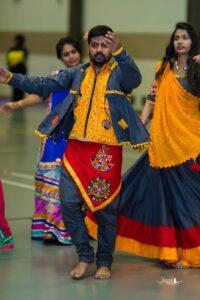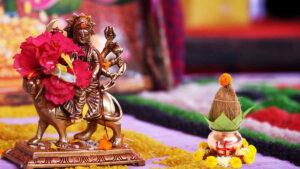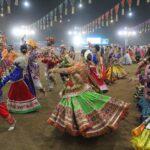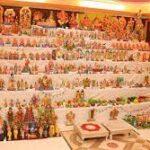Navratri 2023: The Ultimate Guide to India's Biggest Festival

Chetna , Ethnic Attire
Table of Contents
ToggleDt. 15-Jun-23
Introduction to Navratri 2023
Navratri, the nine-night festival, is one of India’s most significant and vibrant celebrations. It is dedicated to the worship of the Hindu goddess Durga and is observed with great enthusiasm and devotion across the country. If you’re looking for the ultimate guide to Navratri 2023, you’ve come to the right place. Here’s everything you need to know about this spectacular festival:
Dates of Navratri 2023
Navratri is a Hindu festival that spans nine nights and is celebrated with great enthusiasm in various parts of India. The dates of Navratri can vary from year to year as it follows the lunar calendar.
In 2023, Navratri is expected to begin on Sunday, 15th October and conclude on Monday, 23th October. However, please note that these dates are approximate and may vary slightly depending on the sighting of the moon and regional traditions.

Significance of Navratri

Navratri holds great significance in Hindu culture and is celebrated with fervor and devotion across India and by Hindus around the world. The word “Navratri” translates to “nine nights” in Sanskrit, and the festival spans nine nights and ten days.
Here are some of the key significances of Navratri:
Worship of the Divine Feminine: Navratri is primarily dedicated to the worship of the Divine Feminine in various forms. The festival honors the Goddess Durga, who symbolizes strength, power, and protection. Different regions in India may also venerate other forms of the Goddess, such as Kali, Lakshmi, and Saraswati, during Navratri.
Triumph of Good over Evil: Navratri celebrates the victory of good over evil. The festival commemorates the legend of Goddess Durga’s battle against the buffalo demon Mahishasura and her ultimate triumph. It serves as a reminder that righteousness and virtue will always prevail over darkness and negativity.
Religious Fasting and Devotion: Many people observe fasting during Navratri as a form of devotion. They abstain from consuming certain foods and follow a strict diet. Fasting is believed to purify the mind and body and enhance spiritual growth. It is also seen as a means of expressing gratitude to the Goddess and seeking her blessings.
Cultural Celebrations and Garba/Dandiya Raas: Navratri is a time of vibrant cultural celebrations. In many parts of India, people come together to perform traditional folk dances like Garba and Dandiya Raas. These dances involve rhythmic movements and the use of decorated sticks (Dandiyas) or colorful sticks (Dandiya) while paying homage to the Goddess.
Community and Social Bonding: Navratri brings communities together. People participate in various cultural events, music performances, and religious ceremonies, fostering a sense of unity and togetherness. It is an occasion for family and friends to gather, celebrate, and create lasting memories.
Navratri is a joyous and auspicious time when people seek the blessings of the Divine Feminine, celebrate their cultural heritage, and embrace the values of love, courage, and righteousness.
Rituals and Customs of Navratri
Navratri, a nine-night festival celebrated in honor of the Divine Feminine, is marked by various rituals and customs. Here are some of the common practices observed during Navratri:
Ghatasthapana: On the first day of Navratri, a ritual called Ghatasthapana is performed. It involves the placement of a pot or Kalash filled with holy water and adorned with sacred symbols, usually in the puja (prayer) room or a designated area. The pot symbolizes the presence of the Goddess.
Daily Puja and Offerings: Throughout Navratri, devotees offer prayers to the Goddess, both in homes and temples. They perform daily puja, which includes lighting a lamp (diya), offering flowers, incense, fruits, and other auspicious items to seek the blessings of the Goddess. Devotional songs and mantras dedicated to the Divine Feminine are also chanted during the puja.
Fasting: Many people observe fasting during Navratri as a form of devotion and purification. Fasting practices can vary regionally and individually. Some individuals may observe a complete fast, consuming only water or fruits, while others may opt for partial fasting, avoiding certain foods like grains, onions, garlic, and non-vegetarian items. Fasting is seen as a way to cleanse the body and mind and demonstrate self-discipline and devotion.
Garba and Dandiya Raas: One of the most popular aspects of Navratri is the energetic folk dances called Garba and Dandiya Raas. People, dressed in traditional attire, form circles and dance to the rhythmic beats of Garba music. In Dandiya Raas, participants use decorated sticks (Dandiyas) while dancing. These dance forms symbolize the joyous celebration of the triumph of good over evil.
Kanya Puja: On one of the Navratri days, usually the eighth or ninth day, Kanya Puja (worship of young girls) is performed. Nine young girls, considered embodiments of the Goddess, are invited to homes or temples and offered food, gifts, and blessings. This ritual signifies the reverence towards the divine feminine energy and the recognition of young girls as manifestations of the Goddess.
Navratri Fairs and Celebrations: In different parts of India, especially in Gujarat and West Bengal, Navratri fairs and celebrations take place. These fairs feature cultural performances, music concerts, traditional arts and crafts, and vibrant decorations. They provide a platform for people to come together, participate in festive activities, and enjoy the spirit of Navratri.
These are some of the rituals and customs associated with Navratri. It’s important to note that practices may vary across regions and individual preferences, but the underlying essence remains the worship of the Divine Feminine and the celebration of spirituality, unity, and joy.
Regional Variations of Navratri
Navratri is celebrated with great enthusiasm throughout India, and different regions have their unique variations and customs associated with the festival. Here are some notable regional variations of Navratri:
Gujarat: Navratri in Gujarat is renowned for its grandeur and vibrant celebrations. The state is known for the traditional folk dance called Garba, where men and women dressed in colorful attire form circles and dance to rhythmic music. The dance is performed with great energy and enthusiasm throughout the nights of Navratri. The festival is also marked by the installation of beautifully decorated idols of the Goddess, called Matajis, in specially constructed pavilions known as Garbi Mandaps.
West Bengal: In West Bengal, Navratri is celebrated as Durga Puja, which culminates in the grand festival of Durga Puja. The focus is on the worship of Goddess Durga, who is believed to descend to Earth during this time. Magnificent pandals (elaborate temporary structures) are created, depicting various mythological scenes and showcasing artistic craftsmanship. The festival involves elaborate rituals, cultural performances, and the immersion of Durga idols on the last day, known as Vijayadashami or Dussehra.
North India: In states like Uttar Pradesh and Delhi, Navratri is marked by the enactment of the Ramayana through stage plays called Ramlila.
South India: In Tamil Nadu, Karnataka, and Andhra Pradesh, Navratri is celebrated as Golu, where dolls and figurines are displayed in creatively arranged steps.
These are just a few examples of the regional variations of Navratri in India. Each region adds its own distinct flavor, customs, and rituals to the festival, making Navratri a truly diverse and vibrant celebration across the country.
Goddesses Worshiped During Navratri

During Navratri, the nine nights and ten days of worship are dedicated to various forms of the Divine Feminine. The specific goddesses worshipped may vary based on regional traditions and personal preferences. Here are some of the prominent goddesses commonly revered during Navratri:
Goddess Durga: Goddess Durga is one of the central deities worshipped during Navratri. She is believed to embody the divine feminine energy and is revered as the ultimate source of power and protection. Goddess Durga is depicted as a warrior goddess who vanquishes evil forces, symbolizing the victory of good over evil.
Goddess Lakshmi: Goddess Lakshmi is worshipped during Navratri for blessings of wealth, prosperity, and abundance. She is regarded as the goddess of fortune and is revered for bestowing material and spiritual wealth upon her devotees. Goddess Lakshmi is depicted as the epitome of grace, beauty, and divine blessings.
Goddess Saraswati: Goddess Saraswati is revered for her association with knowledge, wisdom, arts, and learning. During Navratri, students, artists, and seekers of knowledge pay homage to Goddess Saraswati. She is depicted as the embodiment of wisdom, creativity, and eloquence.
Goddess Kali: In some regions, especially in West Bengal, the fierce form of Goddess Kali is worshipped during Navratri. Goddess Kali symbolizes destruction of evil and ignorance. She is revered as the divine mother who protects her devotees and destroys negativity and darkness.
Nine Forms of Durga: Each of the nine nights of Navratri is dedicated to the worship of a specific form or manifestation of Goddess Durga. These forms include Shailaputri, Brahmacharini, Chandraghanta, Kushmanda, Skandamata, Katyayani, Kalaratri, Mahagauri, and Siddhidatri. Each form represents a unique aspect of the goddess and is worshipped with specific rituals and prayers.
It’s important to note that the specific goddesses worshipped during Navratri can vary based on regional customs, family traditions, and individual beliefs. The essence of Navratri lies in celebrating and honoring the divine feminine energy in all its forms and manifestations.
Dance and Music of Navratri
Dance and music play a significant role in the celebration of Navratri. The festival is marked by energetic and joyful folk dances that are accompanied by vibrant music. Here are some popular dance forms and music associated with Navratri:
Garba: Garba is a traditional dance form that originates from the state of Gujarat. It is performed in circles by men and women, often dressed in colorful traditional attire. Participants move in a synchronized pattern, clapping their hands or holding them in a specific position, while gracefully rotating in circular motions. Garba dances are accompanied by traditional Gujarati music, which includes instruments like dhol, tabla, and harmonium. The songs sung during Garba are often devotional and express the joy and celebration of Navratri.
Dandiya Raas: Dandiya Raas is another popular dance form associated with Navratri, particularly in Gujarat and some other parts of India. In Dandiya Raas, dancers hold decorated sticks called Dandiyas and form pairs or groups. They move in a rhythmic pattern, striking their Dandiyas together in synchronized steps. Dandiya Raas is often performed in a fast-paced and energetic manner, accompanied by lively music and traditional folk songs.
Raas Leela: Raas Leela is a dance form commonly performed during Navratri in the state of Manipur. It depicts the divine love between Lord Krishna and Radha. Dancers form a circular pattern and perform graceful movements, often imitating the playful actions of Lord Krishna and Radha. Raas Leela is accompanied by devotional songs and rhythmic beats of drums, cymbals, and other traditional musical instruments.
Bhavai: Bhavai is a folk dance form that originated in the desert regions of Rajasthan. During Navratri, Bhavai dancers perform intricate movements while balancing pots or brass pitchers on their heads. The dance incorporates elements of acrobatics, showcasing the skill and agility of the performers. The music accompanying Bhavai is a mix of traditional Rajasthani folk tunes and rhythms.
Classical Dance Performances: Navratri also provides a platform for classical dance performances, especially in South India. Bharatanatyam, Kathak, Odissi, and other classical dance forms are showcased during Navratri celebrations. These dance performances are often based on mythological stories and express devotion to the divine through intricate footwork, hand gestures, and expressions. The accompanying music for classical dances includes classical Indian ragas and compositions.
These dance forms and music styles bring immense joy, cultural richness, and a sense of togetherness during Navratri celebrations. They embody the spirit of celebration, devotion, and the triumph of good over evil, making Navratri a time of vibrant festivities and artistic expressions.
Navratri Special Food and Cuisine
Navratri is not just a festival of dance and worship but also a time when special foods and cuisines are prepared and enjoyed. During Navratri, there are certain dietary restrictions and preferences observed by many people, as they choose to abstain from certain ingredients like grains, onions, garlic, and non-vegetarian items. Here are some popular Navratri special foods and dishes:
Sabudana (Tapioca) Khichdi: Sabudana Khichdi is a popular and widely consumed dish during Navratri. It is made by sautéing soaked sabudana (tapioca pearls) with peanuts, potatoes, and spices. It is a light and filling dish often served for breakfast or as a snack during fasting days.
Kuttu (Buckwheat) Paratha: Kuttu ka Paratha is a flatbread made from buckwheat flour. It is a nutritious and gluten-free option, commonly eaten during Navratri. The parathas are typically served with yogurt or aloo (potato) curry, providing a wholesome meal.
Singhare (Water Chestnut) Kebabs: Singhare ke Kebab is a delicious snack made with water chestnut flour, mashed potatoes, and spices. These kebabs are pan-fried or shallow-fried and are a popular Navratri delicacy.
Rajgira (Amaranth) Puri: Rajgira Puri is a deep-fried bread made from amaranth flour. It is a common item prepared during Navratri fasting. The puris are often enjoyed with potato curry or yogurt.
Samak (Barnyard Millet) Rice: Samak Rice, also known as vrat ke chawal, is a common grain substitute used during Navratri. It is cooked like regular rice and served with curries or yogurt-based dishes.
Makhana (Fox Nuts) Snacks: Makhana, or fox nuts, are commonly consumed as snacks during Navratri. These roasted or fried lotus seeds are crunchy and nutritious. They are often seasoned with spices like black pepper, rock salt, or chaat masala.
Fruit Salad: A refreshing and healthy option during Navratri is a fruit salad. A variety of fruits like bananas, apples, pomegranates, and oranges are chopped and mixed together to create a colorful and nourishing salad.
Sweets and Desserts: Navratri is also a time for indulging in sweet treats. Sweets like Singhare ke Atte ka Halwa (water chestnut flour halwa), Kaju Katli (cashew fudge), and Makhana Kheer (fox nut pudding) are popular choices during the festival.
It’s important to note that the specific dishes prepared during Navratri can vary based on regional preferences and individual choices. These Navratri special foods cater to the dietary restrictions and are enjoyed by people who observe fasting and participate in the festivities.
Dressing for Navratri
Navratri is a vibrant and joyous festival, and people often dress up in colorful and traditional attire to celebrate the occasion. Here are some suggestions for festive attire and makeup for Navratri:
Traditional Outfits:
-
- Women: Women commonly wear traditional ethnic attire like chaniya cholis (flared skirts paired with blouses) or ghagra cholis (long skirts paired with blouses). These outfits are often embellished with colorful embroidery, mirror work, or sequins. They are accompanied by a dupatta (stole) draped elegantly. Some regions have specific traditional attire for Navratri, like the Gujarati-style chaniya choli.
-
- Men: Men typically wear traditional kurta pyjama or dhoti kurta paired with a waistcoat or jacket. These outfits are often in vibrant colors and may be accessorized with a turban or traditional headgear.

Jewellery and Accessories:
-
- Women: To complement their attire, women adorn themselves with traditional jewelry like oxidized silver or gold-plated necklaces, earrings, bangles, and anklets. They may also wear maang tikkas (forehead ornaments) and nose rings. The jewelry often features intricate designs and vibrant gemstones.
-
- Men: Men can accessorize their outfits with ethnic jewelry like necklaces, bracelets, or brooches. They may also wear turbans or saffas (head turbans) with decorative embellishments.
Makeup:
-
-
- Women: Navratri makeup typically includes a focus on bright and bold colors. The eyes are often highlighted with vibrant eyeshadows in shades of gold, green, blue, or pink. Winged eyeliner and false eyelashes can add drama. Cheeks can be accentuated with a rosy blush, and lips can be adorned with bright lip colors like red, fuchsia, or coral. Glitter or shimmer can be added to enhance the festive look.
- Men: Men may opt for a natural or minimal makeup look. This can include grooming facial hair, using concealer or foundation for an even complexion, and adding a touch of lip balm.
-

Hairstyles:
-
- Women: Women often prefer traditional hairstyles like braids, buns, or loose curls adorned with flowers, hair accessories, or decorative hairpins. These hairstyles add an elegant and festive touch to the overall look.
-
- Men: Men can style their hair neatly with a side parting, slicked-back hair, or a well-groomed beard and mustache, based on their preferences.

Remember, the choice of attire, makeup, and accessories for Navratri can vary based on personal preferences, regional traditions, and cultural influences. The main idea is to embrace the festive spirit, express creativity, and celebrate the joyous occasion of Navratri in style.
Precautions and Safety
During Navratri celebrations, it’s important to prioritize safety and take certain precautions to ensure a safe and enjoyable experience for everyone involved. Here are some precautions and safety measures to keep in mind during Navratri:
Traffic Safety: During Navratri, there may be increased traffic due to various events and celebrations. Be cautious while traveling and follow traffic rules to ensure your safety and the safety of others. Use designated pedestrian crossings when crossing roads and remain vigilant while driving or walking.
Personal Belongings: Take care of your personal belongings, such as wallets, mobile phones, and purses, especially in crowded areas. Keep them secure and within sight to prevent theft or loss.
Footwear Safety: Choose comfortable and appropriate footwear for the occasion. Avoid wearing high heels or uncomfortable shoes that may cause discomfort or increase the risk of tripping or falling, especially during energetic dance performances or crowded spaces.
Hydration and Nutrition: Maintain proper hydration by drinking enough water throughout the day, especially if you are participating in activities that involve physical exertion. Consume nutritious food and avoid consuming food from unhygienic or unreliable sources.
Personal Safety: Be aware of your surroundings and trust your instincts. Stay with a group of friends or family members, especially during late-night events or in unfamiliar places. Avoid isolated areas and maintain personal boundaries.
Remember, safety should be a top priority during Navratri celebrations. By following these precautions and remaining vigilant, you can ensure a safe and enjoyable experience for yourself and those around you.
Conclusion
Navratri is a time of joy, devotion, and cultural celebration in India. It brings communities together in an atmosphere of positivity and spirituality. Whether you’re a local or a visitor, embracing the spirit of Navratri promises an unforgettable experience.
We are ready with wide ranges of selection in customized outfits for Navratri 2023 for ladies.







